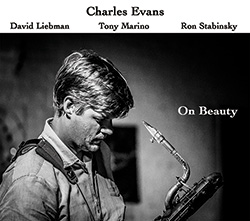
NY baritone saxophonist Charles Evans wrote this through-composed 9 part work for soprano saxophone great David Liebman, who joins Evans in a quartet with pianist Ron Stabinsky and bassist Tony Marino, performing a chamber jazz work of strong melody and subtle allure.
Out of Stock
Quantity in Basket: None
Log In to use our Wish List
Shipping Weight: 3.00 units
Sample The Album:
Charles Evans-baritone saxophone
David Liebman-soprano saxophone
Ron Stabinsky-piano
Tony Marino-bass
Click an artist name above to see in-stock items for that artist.
UPC: 888295222204
Label: More Is More
Catalog ID: MIM152
Squidco Product Code: 20769
Format: CD
Condition: New
Released: 2015
Country: USA
Packaging: Digipack
Recorded at Spectra Sound Recording in Nazareth, Pennsylvannia, on june 24th, 2014 y Jim McGee.
"Charles Evans' On Beauty presents the seasoned baritone saxophone artist as a unique voice in the creative music community. On this audacious new project, written specifically for soprano saxophone great David Liebman, Evans has devised methods of combining chromatic harmony with improvisation, employing the rare combination of the baritone and soprano saxophones.
Evans and Liebman celebrate the CD in a special concert on Friday, June 19 at Greenwich House Music's Sound it Out Series in NYC. Joining them are Ron Stabinsky on piano and Tony Marino on bass. Evans also celebrates with two dates in Brooklyn: May 14 with Stabinsky, Marino and Dan Blake on soprano at Shapeshifter Lab and May 23 in a solo gig at The Firehouse Space.
Liebman put down the tenor saxophone for fifteen years to fully actualize his desire for a personal soprano voice. Evans, the apprentice, has followed Liebman's lead in many ways. Specifically, the exclusive devotion to the soprano's distant lower relative, the baritone, for nearly twenty years has rendered him ready for profound creation with the premiere living soprano master.
Each subsequent recording shows that Evans is continuing to go deeper into the development of a very personal approach both to playing his instrument and composing music perfectly suited to his playing style. As his work progresses, even the very open term "jazz" is beginning to seem too confining a term to describe his music. He has arrived at the point of simply sounding like Charles Evans. His work is highly expressive and often complex, but not in a way that aims to overwhelm. He achieves all through the subtlety and control that comes from years of single-minded pursuit of ideals without compromise.
The baritonist has worked diligently to broaden the expressive range of his instrument, with specific care towards the difficult altissimo register (featured very lyrically and eloquently here) as well as the application of chromatic improvisation/composition on the big horn. The music is strengthened by the use of freely associated triads, intervals, and chromatic lines in polyphonic improvisation with the other members of the group. The quartet members truly leave their egos at the door, beautifully expressing and understanding the composer's musical vision.
Accompanying the saxophonists are two musicians that are masters in their own right. Bassist Tony Marino, through his longtime tenure in various Liebman groups, brings a level of artistry on the upright that is rarely matched. His experience, and ability to adapt to the challenges of both the improvisational and written material, was indispensable in this undertaking. Pianist Ron Stabinsky can be heard in a variety of creative musical settings, from his new role in Mostly Other People Do the Killing to his recent work with trumpet virtuoso Peter Evans. Stabinsky proves to be the glue to the ensemble, bringing an incredible precision to the notation, along with a creative versatility to each movement of the piece.
Evans' music is genre nonspecific and avoids employing the traditional jazz vocabulary. The combination of jazz instruments, 20th-century classical techniques and harmonies, and free improvisation demonstrate Evans' refusal to be limited or allow his music to be pigeonholed. A preference for the subtle and delicate is often demonstrated, vs. traditional jazz virtuosity. Compositionally, the music grew from the successes of the quartet's first CD Subliminal Leaps. The baritonist's intent is to deepen the most beautiful attributes from the first record, thereby reaching further avenues of artistic expression.
"On Beauty," a composition written for Liebman's specific instrumental voice, utilizes devices with him in mind, many of which were cultivated and refined in past years by the innovative saxophonist. Evans contemplates beauty by taking a very close look at the finest musical qualities in the quartet's repertoire. Several polychord progressions are featured in the piece. Thematic melodies (at times appearing in variation such as retrograde) are derived from the harmonic material, and vice versa. These melodies are thoroughly exhausted throughout the work and reimagined, from the subtle eloquence of Movement I to the lively polytonal march of Movement II. Writing for two independent simultaneous duos takes precedence in Movement III and IV, where the quartet reaches a healthy balance of improvised vs. written material. Surprise is a virtue throughout, as the composition is varied by interruptions that lead the music to unexpected places. The use of the baritonist's virtuosic altissimo register is fully explored in tasteful ways, stating melodies both in duo with the soprano and also in support of Liebman's masterful polychordal improvisations. Ending Beauty brings back the themes, this time reharmonized, leading to a surprising up-tempo trading section and ending with the saxophone pair in duo at their introspective finest. This compositional cohesion is a fine example of the actualization of Evans' writing within Liebman's personal unique language, with all parties demonstrating profound and heartfelt improvisations.
Charles Evans was raised in a small town named Factoryville, Pennsylvania. He began intensive baritone saxophone study with the late Bill Zaccagni at the University of the Arts in Philadelphia. During this time he also studied with David Liebman, who instilled an artistic mindset in the young baritonist and inspired him to pursue music to his fullest potential. Following Liebman's cue, Evans moved to New York, where he received a master's degree in jazz performance while studying with Antonio Hart. Shortly thereafter, he completed the Music Education program at Queens College for state certification.
Among Evans' seven releases is his March 2009 multi-layered solo baritone saxophone release, The King of All Instruments, which earned wide praise including 5 stars in DownBeat Magazine and helped enable Evans to consistently place in the DownBeat Annual Critics Poll on baritone saxophone. As Hank Shteamer said in his Time Out New York review: "Evans is dead serious about getting the most out of his regal horn. Hypnotic and, in spots, powerfully creepy, it's a singular statement from a composer expressing profound art." He continued to develop his non-tonal writing and playing with Live at St. Stephens (2009) receiving "Best New Release, 2010-Honorable Mention" in All About Jazz magazine. In 2013 Evans placed 4th in the "Rising Star Baritone Saxophone" category of DownBeat. As Michael Jackson noted in his 5 Star DownBeat review, "My highest marks are for originality and audacity, but there is a more profound inner communion here."
Perhaps it could be said that the baritone saxophone has a new leader, one who sees possibilities previously unexplored. Uniquely, Evans places composition on an equal level of importance to his playing, a quality that has proven instrumental in reaching sincere, personal, depth and expression. As Alain Drouot of DownBeat Magazine said about Subliminal Leaps, "The exchange on the opener shows that the saxophonists did not need much time to get acquainted. The unusual marriage (of baritone and soprano saxes) bears some impressive fruit on this outstanding new album." Subtle, dissonant, and emotional, Charles Evans has used the very same lineup and musical language to create a unique and expressive work of art once again, with the release of On Beauty"-More Is More
"Baritone sax phenom and jazz composer Charles Evans has been giving us much to like with his consistently worthwhile albums, more than a few by now, and he shows no signs of letting up. If there is such as thing as sophomore jinx in jazz, and I am not sure there is, he is not one prone to it. Quite the opposite. The new one delves deeply into an avant chamber jazz that consists of a multi-part composition-improvisational platform called On Beauty (More is More 152). It is a through composed suite by Charles featuring himself of course on baritone, his mentor David Liebman on soprano, Ron Stabinsky on piano and Tony Marino on bass. Evans and Liebman have a very inspired improvisational presence, both separately and collectively, as they weave improv with the compositional material. Ron Stabinsky plays his very modern harmonically extended parts and adds some brilliant improvisations as well. And bassist Tony Marino brings up the bottom with a full tone and good ideas. This is music that plays structure against freedom in ways that may remind you of early AACM or even Jimmy Giuffre in his more outside period when Paul Bley and Steve Swallow were key members in his ensemble. But that only covers precedents, not things imitated, for Charles comes through once again as a determined and eloquent musical personality, a baritone of stature but also a music composer-director who has direction and purpose, who succeeds in carving out his own new jazz turf in ways that make you listen and appreciate. It is one more landmark-signifying notch in the musical belt of Mr. Charles Evans. It is more-or-less required listening for anyone who wants to explore the newness to be had out there today. Formidable music!"-Grego Applegate Edwards, gapplegatemusicreview.blogspot.com
Artist Biographies
• Show Bio for Charles Evans "Charles Evans is an American baritone saxophonist based in New York, who specializes in chromatic improvisation/composition and traditional jazz. Evans has been a member of the New York City creative music community since 2002, when he moved to the city after graduation from the University of the Arts in Philadelphia. He then went on to earn a Master's in Jazz Performance from Queens College, as well as NYS teacher certification. He has studied with David Liebman, Julian Sparacino, Jim Buckley, the late Bill Zaccagni, Chris Farr, Ron Kerber, John Swana, Tony Miceli, George Garzone, Hamiet Bluiett, and Antonio Hart. Charles has received rave reviews with five albums as a leader, including an all-baritone multi-layered record entitled, "The King of All Instruments," which received a 5 star review in Downbeat Magazine. He has also been included in both the Critics' and Readers' polls in the aforementioned magazine, in both the Rising Star and Baritone Saxophone categories. Live at St. Stephens received "Best New Release 2010 - Honorable Mention," in All About Jazz magazine. His upcoming CD will feature an original composition written for collaboration with his mentor David Liebman. The baritonist has worked diligently to broaden the expressive range of his instrument, with specific care towards the difficult altissimo register as well as the application of chromatic improvisation/composition on the big horn. Musical projects include a chromatic/improvisational quartet with his mentor David Liebman, Ron Stabinsky, and Tony Marino; micro-tonal bebop in The Language Of with Peter Evans, Moppa Elliott, and Jan Roth, (It Needs It, No Relation) introspective duos with Neil Shah (Live at St. Stephens,) Erik Dutko (Ballads,) and Ron Stabinsky; and straight-ahead jazz with a former prized student in The David Jimenez Quintet. Evans has been steadfast in his commitment to non-compromising music. To solve the obvious financial burden, he started a highly successful high school band program in Queens, NY. He places his teaching on equal footing with his artistic pursuits, and has learned that sharing his passion is just as meaningful as expressing personal music." ^ Hide Bio for Charles Evans • Show Bio for David Liebman "NEA Jazz Master (2011) David Liebman's career has spanned nearly five decades, beginning in the early 1970s as the saxophone/flautist in both the Elvin Jones and Miles Davis Groups, continuing as a bandleader since. He has played on over five hundred recordings with nearly two hundred under his leadership and co-leadership. In jazz education he is a renowned lecturer and author of several milestone books: Self Portrait Of A Jazz Artist, A Chromatic Approach To Jazz Harmony And Melody, Developing A Personal Saxophone Sound (translated into multiple languages), in addition to teaching DVDs, journalistic contributions to periodicals and published chamber music. Lieb's autobiography What It Is-The Life Of A Jazz Artist (Scarecrow Press) is a fascinating look into Lieb's career. His bands over the years have included noted musicians such as John Scofield, Richie Beirach, Bob Moses, Billy Hart and others. The current group Expansions features some of the best of the younger generation. Lieb is the Founder and Artistic Director of the International Association of Schools of Jazz (IASJ) existing since 1989, which is a worldwide network of schools from nearly 40 countries. Liebman's awards, besides the NEA honor include the Jazz Educators Network (JEN) Legends of Jazz (2013); the Order of Arts and Letters (France 2009); Jazz Journalist's award for Soprano Saxophone (2007); Grammy nomination for Best Jazz Solo (1998); Honorary Doctorate from the Sibelius Academy (Finland-1997). He is currently teaching at the Manhattan School of Music and a guest lecturer at Berklee College of Music. Dave has consistently placed in the top positions for Soprano Saxophone in the Downbeat, Jazz Times and JazzEd polls since 1973." ^ Hide Bio for David Liebman • Show Bio for Ron Stabinsky "Ron Stabinsky recently released his debut album, Free for One, the culmination of more than a decade of evolving his improvised solo language. In addition to continuing to pursue his ongoing interest in solo piano improvisation, he enjoys working on music in a stylistically diverse array of situations throughout the United States and Europe with many other musicians and ensembles, including free-improvising saxophonist Jack Wright, bass trombone virtuoso David Taylor, Meat Puppets bassist Cris Kirkwood, and NEA Jazz Master David Liebman. Recent festival appearances include Newport Jazz Festival, North Sea Jazz Festival (Netherlands), Moers Festival (Germany), Jazzfestival Saalfelden (Austria), Outreach Festival (Austria), and Jazz and More Festival Sibiu (Romania). He is currently a regular member of the band Mostly Other People Do the Killing, the new music ensemble Relâche, the Charles Evans Quartet, and the Peter Evans Quintet." ^ Hide Bio for Ron Stabinsky
11/20/2024
Have a better biography or biography source? Please Contact Us so that we can update this biography.
11/20/2024
Have a better biography or biography source? Please Contact Us so that we can update this biography.
Have a better biography or biography source? Please Contact Us so that we can update this biography.
Track Listing:
1. Introduction 5:10
2. Movement I 6:07
3. Interlude I 1:12
4. Movement II 5:08
5. Movement III 7:23
6. Movement IV 10:49
7. Movement V 5:40
8. Interlude II 1:02
9. Ending Beauty 5:06
Improvised Music
Jazz
NY Downtown & Metropolitan Jazz/Improv
Quartet Recordings
Melodic and Lyrical Jazz
Chamber Jazz
Search for other titles on the label:
More Is More.


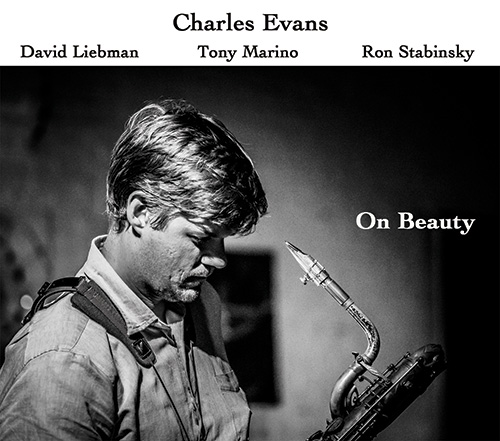


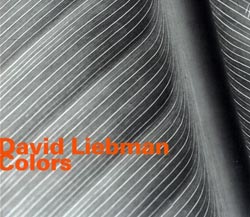
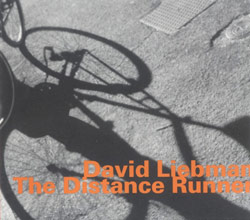

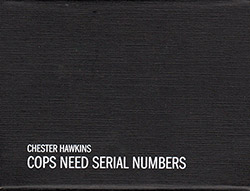

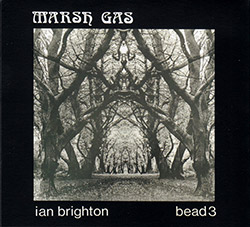
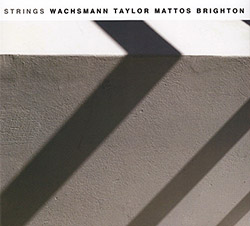








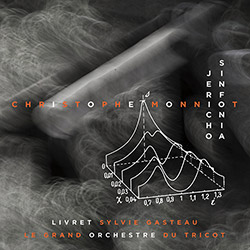


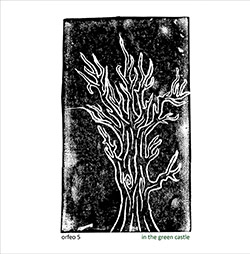



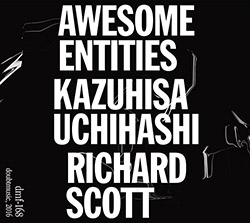



![Guy, Barry / Ken Vandermark: Occasional Poems [2 CDs]](https://www.teuthida.com/productImages/misc4/34849.jpg)
![Novoa / Carter / Mela Trio: Vol.1 [VINYL]](https://www.teuthida.com/productImages/misc4/35236.jpg)


![Elephant9 : Mythical River [VINYL]](https://www.teuthida.com/productImages/misc4/34624.jpg)
![Evans, Peter (Evans / Eldh / Black): Extra [VINYL]](https://www.teuthida.com/productImages/misc4/35279.jpg)

![McPhee, Joe: Straight Up, Without Wings [BOOK]](https://www.teuthida.com/productImages/misc4/35454.jpg)
![Jeck, Philip: rpm [2 CDs]](https://www.teuthida.com/productImages/misc4/35455.jpg)













![Barker / Parker / Irabagon: Bakunawa [VINYL]](https://www.teuthida.com/productImages/misc4/35533.jpg)
![Blaser, Samuel / Marc Ducret / Peter Bruun: Dark Was The Night, Cold Was The Ground [VINYL 10-inch]](https://www.teuthida.com/productImages/misc4/35492.jpg)








![Warren, Kenny (Warren / Hoffman / Ellman): Sweet World [VINYL]](https://www.teuthida.com/productImages/misc4/35451.jpg)




![Blake, Ran / Dave Knife Fabris: Live Amsterdam 2006, First Visit [CD + POSTCARDS]](https://www.teuthida.com/productImages/misc4/35275.jpg)













![DNS: Taking Big Bites Of The Khandas Three Cafes Deep [2 CDs]](https://www.teuthida.com/productImages/misc4/35334.jpg)




![Cleaver, Gerald: The Process [VINYL]](https://www.teuthida.com/productImages/misc4/34966.jpg)




![Alva Noto: HYbr:ID II [VINYL 2 LPs]](https://www.teuthida.com/productImages/misc4/35201.jpg)

![Baron, Derek / Luke Martin: Distinct and Concealed [CASSETTE + DOWNLOAD]](https://www.teuthida.com/productImages/misc4/35079.jpg)

![Lyle, Erica Dawn : Colonial Motels [CASSETTE + DOWNLOAD]](https://www.teuthida.com/productImages/misc4/35080.jpg)









![Sanna, Claudio: Compositori Sardi Contemporanei II [2 CDs]](https://www.teuthida.com/productImages/misc4/35317.jpg)







![Zurria, Manuel: Fame di Vento [3 CDs]](https://www.teuthida.com/productImages/misc4/35167.jpg)

![Granberg, Magnus / Nattens Inbrott / Skogen: Holde Traume, Kehret Wieder! [2 CDs]](https://www.teuthida.com/productImages/misc4/35038.jpg)
![Frey, Jurg: Outermost Melodie [2 CDs]](https://www.teuthida.com/productImages/misc4/35039.jpg)

![Pavone, Jessica: Reverse Bloom [VINYL]](https://www.teuthida.com/productImages/misc4/34895.jpg)




![Modney (Modney / Wooley / Gentile / Roberts / Pluta / Symthe / ...): Ascending Primes [2 CDs]](https://www.teuthida.com/productImages/misc4/34852.jpg)









![Elephant9 with Terje Rypdal: Catching Fire [VINYL 2 LPs]](https://www.teuthida.com/productImages/misc4/35355.jpg)
![Deerlady (Obomsawin, Mali / Magdalena Abrego): Greatest Hits [VINYL]](https://www.teuthida.com/productImages/misc4/34876.jpg)




![Haino, Keiji: Black Blues [2 CDs]](https://www.teuthida.com/productImages/misc4/35109.jpg)



![Surplus 1980: Illusion of Consistency [CD]](https://www.teuthida.com/productImages/misc4/35069.jpg)
![Staiano, Moe: Away Towards the Light [VINYL + DOWNLOAD]](https://www.teuthida.com/productImages/misc4/35037.jpg)



![Caveira (Gomes / Sousa / Abras / Ferrandini): Ficar Vivo [VINYL]](https://www.teuthida.com/productImages/misc4/34643.jpg)
![Gregg, J. J. / David Van Auken: Lunar Prairie [CD w/ DOWNLOAD]](https://www.teuthida.com/productImages/misc4/34611.jpg)

![Coultrain: Mundus [VINYL]](https://www.teuthida.com/productImages/misc4/32439.jpg)
![Mattin: Songbook #6 [VINYL]](https://www.teuthida.com/productImages/misc4/27317.jpg)
![Punkappella: Wake Up [7-inch VINYL]](https://www.teuthida.com/productImages/misc4/17519.jpg)
![Residents, The: WARNING: UNiNC.: Live And Experimental Recordings 1971-1972 [VINYL 2 LPs]](https://www.teuthida.com/productImages/misc4/31521.jpg)
![Coultrain: Phantasmagoria [VINYL]](https://www.teuthida.com/productImages/misc4/30142.jpg)
![Lennon, Sean Ono: Asterisms [VINYL]](https://www.teuthida.com/productImages/misc4/34517.jpg)

![Coley, Byron: Dating Tips for Touring Bands [VINYL]](https://www.teuthida.com/productImages/misc4/17906.jpg)

![Lost Kisses: My Life is Sad & Funny [DVD]](https://www.teuthida.com/productImages/misc4/lostKissesDVD.jpg)